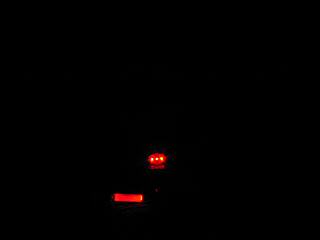Start
Active lighting Passive lighting
Comparing active & passive visibility in darkness
What about daytime visibility?
Visibility doesn't guarantee safety
|
More comparisons of active and passive visibility equipment
Here's a sample scene I'll use to demonstrate some points about active and passive visibility. I want to emphasize that this scene is not intended to portray a real-world rear-visibility scenario. The photos below are only intended to demonstrate how reflectors and other passive visibility items are not always effective, and that active lights will show in situations where passive ones will not.

click to enlarge
- Neon-yellow jacket with reflective piping
- Cheap vest with reflective tape
- Amber automotive-type reflector
- Round red wide-angle bicycle reflector
- Cateye LD500 taillight
- Roll of TrimBrite reflective tape
- Jog-A-Lite reflective legband
- Nathan self-illuminating reflective legband
- A pedal with an amber pedal reflector
- The backdrop is dark-colored cloth, so you can consider it representative of dark-colored clothing.
 
The first comparison (above right) shows the scene illuminated with a very powerful light that is lined up as close to the camera's line of sight as possible. This would be like a motorist aiming high-beam headlights at the scene and viewing it from between the headlights. The jacket is visible, and the reflective items are quite visible.
|
 
The second comparison shows the scene with a weak light that is still lined up as close to the camera's line of sight as possible. The jacket is no longer visible, you can just see a trace of its reflective piping. The other passive visibility items are still quite visible. This might be representative of what a motorist would see if I were on the fringes of his/her low-beam headlights, rather than in the "hot spot."
|
 
The third comparison shows the scene with no light at all. All the passive visibility equipment is now invisible, because there is no incoming light for it to reflect back. Only the active visibility items that emit light by themselves are visible. This is what a motorist will be able to see in total darkness, if his/her headlights are not aiming at me (or not turned on), and no other light sources are shining on me either. This is also what a pedestrian or other non-lighted road user would be able to see in darkness.
|
 
The fourth comparison illustrates a different concept. There's a strong light aimed at the scene again, but this time the light source is not lined up with the camera's line of sight. The retroreflective items are still reflecting the light back towards the light source, but since the light source isn't close to the camera anymore, they don't appear bright from the camera's viewpoint. The active lights and the jacket are the only items providing meaningful visibility now. This picture might be representative of how I'd appear in a brightly-lit downtown area to a pedestrian, or to a motorist who failed to notice that his headlights aren't turned on as he pulls out of a brightly-lit parking lot.
|
Next: What about daytime visibility?
|
 ©
©
 ©
©